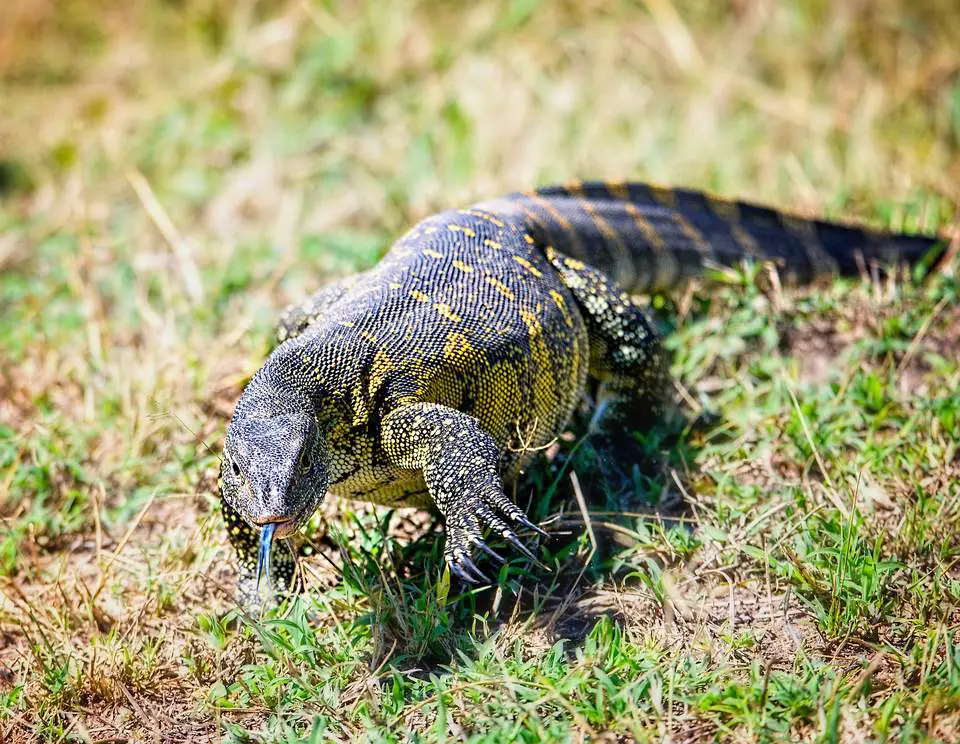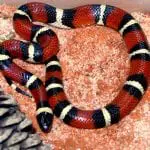Scientific Facts
| Common Name | Nile Monitor |
| Scientific Name | Varanus niloticus |
| Family | Varanidae |
| Habitat | Rivers, water bodies; all over Africa except the northwest. |
| Life Span | 15 years |
| Diet | Carnivore. Fish, crocodile eggs, insects, aquatic creatures, and some mammals |
| Size | Up to nine feet in length but more commonly about six feet |
Physical Description
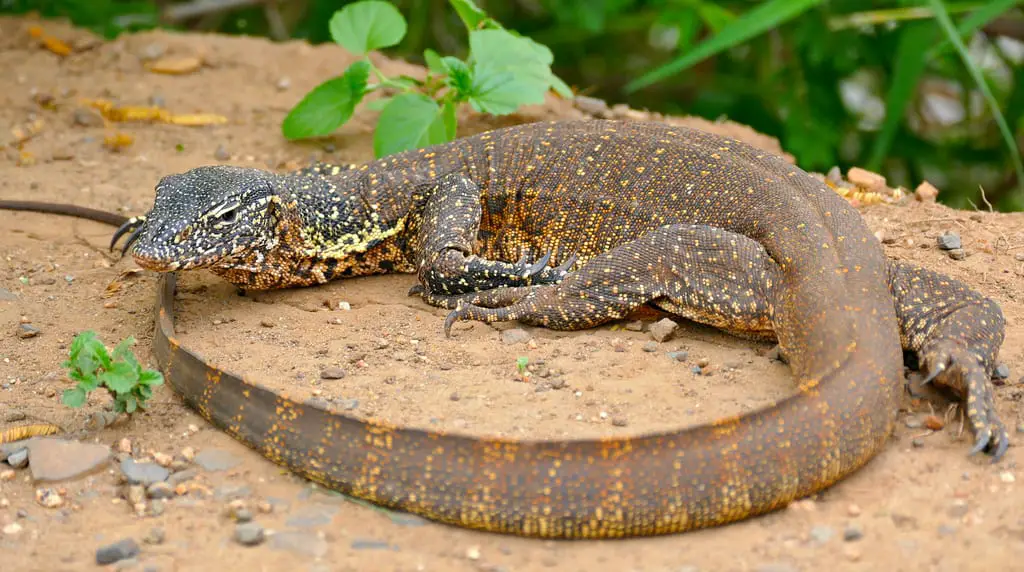
Both male and female Nile Monitors do not exhibit sexual dimorphism or differences when it comes to their physical appearance, weight, and size. These reptiles have a tough physique, and striking skin patterns with beady skin brown, olive green, and grayish-brown in color with greenish-yellow or rosette-like spots distributed along with the head and parts of its body. They have a powerful leg with a long tail that has the capability of grasping.
Their sharp teeth and sharp claw is helpful in tearing food, climbing, digging, and defending themselves. Most Monitor species have forked tongue that has highly olfactory properties. As an indication of their aquatic abilities, their nostrils are situated on their snouts.
Where to Find Them?
The Nile Monitor is a native to Africa, and their species are distributed throughout the other parts of the world, in the central and southern regions of the continents, mostly in Sudan and central Egypt along the Nile River. You cannot see them in the desert area of Africa because they thrive in areas where there are bodies of water.
Monitor Species
Nile Monitor
They are beautiful but temperamental. They are considered to be the largest lizard in, Africa where it can grow up to five feet in length with a weight of around 45 pounds. This monitor is a common captive pet because of its strong resistance to different illnesses, and it is also not a high maintaining reptile.
Black Tree Monitor
As its name implies, it is the color black all throughout its lifecycle. It is a lightweight monitor that has fully adapted to the life of forest canopy. It has long, sharp claws and a semi-prehensile tail that aids it in the treetops by curling around branches
Savannah Monitor
This monitor species is a native to warm forests and grasslands. It is a devout carnivore that only feeds on insects, small rodents, eggs, and flying mammals that are nesting. They grow up to 48 to 55 inches in length and may weigh more than 30 pounds. I
White-Throated Monitor
This monitor grows in a considerably longer in length compared to other monitor species. They wear a striking coat of colors with an earthy coloration. Compared to other monitors, White-Throated Monitors are gentle, but you need to have great patience and diligence in taming it.
Habitat
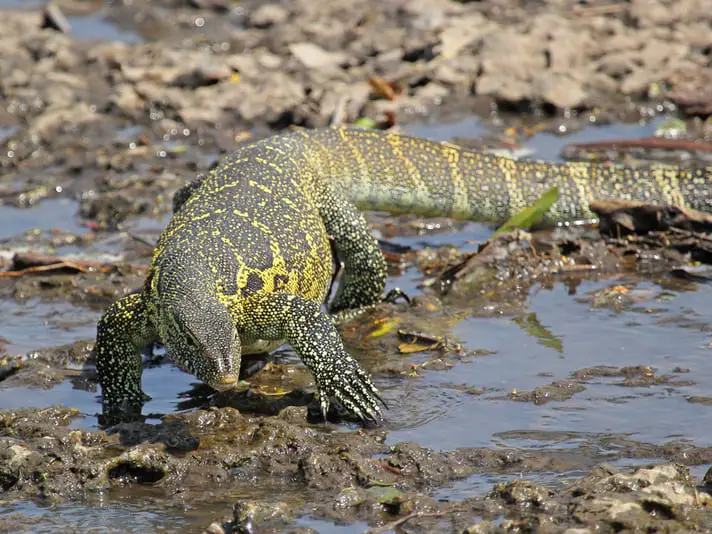
The Nile Monitor can adapt to a wide variety of habitats from dry savannas, woodlands, grasslands, scrub, mangroves, swamps, and tropical rainforests. They can adjust easily to an environment as long as there are water and land source. Since they feed on the eggs of egg-laying mammals, you often see them near nesting sites. Some reptiles only have a common nesting site, so there are some chances that its prey is an egg of a Nile Monitor as well.
Even though this reptile is big, breeders love to take it into captivity because of their good adaptation personality wherein they can thrive anywhere as long as they are still able to move
Behavior and Adaptations
They are considered as an invasive species with a thriving population that proves their adaptability to different environments. They have an aggressive personality from childhood that they can carry out until adulthood, especially if they are grown in their natural environment. Young Nile Monitor shows their uneasiness and feelings of being threatened by whipping their tails while the adults will not hesitate to bite or outrun their possible predator or even humans if they are threatened or stressed.
They are not the friendliest pets that can be tame because even if you would pet it at an early age, there is no assurance that you’ll get their trust because of their ill-temperateness. They are active during the day time and hide or burrow themselves at nighttime. They are often seen basking on the rocks, branches of a tree or near the water. Unlike other reptiles, they have the ability to breathe and stay 20-30 minutes.
Nile Monitors use their sense of sight and sense of taste so that they could sense what’s the environment where they are in has to offer them. They can easily sense if there is harm or danger in a place, so they escape easily. They perceive their environments through visual, auditory, tactile, and chemical stimuli. They would usually live alone during the adolescent stage, but during their younger years, they would remain in groups engaging in mutual tongue-licking, grooming, and body rubbing.
Eating Habits

They represent harm to other native species such as tortoises, owls, birds, and other egg-laying animals because they eat their eggs and hatchlings that may be an additional cause to extinction. They have a broad choice for food that allows them to hunt on the surface and below the ground, in the trees, and in salt and freshwater. They also have an appetite for anything to any moving animal that can be easily grabbed, such as other reptiles, small mammals, insects, shellfish and other sea creatures.
Size and Weight
They can reach over 3.5 meters long (9 ft), which crowns them as one of the largest types of Lizard in Africa. Nile monitors in the same group age don’t possess the same size and weight but they have an average size that ranges between 1.3 to 1.8 meters in length, and their tail’s length measures half of the total length of their upper body. Young Nile Monitor’s weight may range between 0.8 to 1.7 kg (1.8 to 3.7 lb), and the adults have a ranging weight of 5.9 to 15 kg (13 to 33 lb).
Breeding and Reproduction
Breeding Nile monitors are quite challenging, but it is not an impossible one. When the female Nile Monitors reached the age of 2 or when it is about 14 inches in length, that is the time it reaches sexual maturity. The male Nile Monitor would engage in a violent wrestling match with another male monitor for mating opportunities.
The Nile Monitor lay eggs about 20-60, and it may take 6-8 months for it to hatch. Its hatchlings are colorful and attractive, they immediately run into the water. Nile Monitors located in tropical countries or those that are located near the equator can breed and reproduce any time of the year, but in countries mostly in southern regions, they only have a limited timeframe where they can mate, which is from June-July.
How They Lay Eggs
The female Nile monitor would prefer to lay their eggs in the brood of termites where the heat coming from these termites act to incubate the eggs. When they hatch, their baby monitor is tiny versions of their Nile monitor parents. Sometimes the females would return to their shells to break it and free the hatchlings, but on a normal basis, females would leave their eggs; that is why the eggs are eaten by other reptiles and mammals. These hatchlings are expected to mature sexually when they are about 3 years old.
Common Health Problems
Nile Monitors are considered a hardy pet that does not require high maintenance, but there are still factors to consider in making sure that it will grow healthy to reach their maximum lifespan. If you observe an unusual behavior or changes in the physical appearance of your pet, then it is best to seek help from a professional who specializes in taking care of lizards.
Metabolic Bone Disease
This health problem a Nile Monitor may encounter is a result of giving them an incorrect diet. Like humans, they also need calcium to have healthy bones. Not getting enough UVB lighting or exposure to sunlight may also lead to metabolic bone disease
Constipation
They may not be prone to parasitic infections, but they suffer from constipation due to impaction because sometimes they tend to eat unnecessary things that can’t be digested, such as sand and garbage. They do not defecate on a normal basis, and sometimes it would depend on the temperature. Low temperature makes it difficult for the reptile to digest their food so they become constipated. Make sure that your pet’s habitat is equipped with the right temperature and make sure the fresh waterer is readily available to keep them hydrated.
Burns
In captivity, Nile monitors can be prone to burns if the lighting equipment or heat source gets too close. To prevent burning or wounding their skin because of hot temperature, make sure all light and heat sources are placed at a distance that is out of reach of the reptile. Minor burns can be treated by washing it with soap and applying some antiseptic ointment.
Calcium & Vitamin D3 Deficiency
The Nile Monitor suffering from calcium and vitamin D3 Deficiency shows swollen limbs, jaws, and other parts of their body, constipation, softening of the bones, and weight loss. To prevent this illness, exposure to proper lighting, feeding them with the right diet, and supplying them with calcium and vitamin D3 is helpful.
Calcium Over-Supplementation
Calcium and vitamin D3 are vital for the well-being being of your reptile but an oversupply of these vitamins may become toxic for their body. An excessive supplementation to these nutrients may lead to hypercalcemia which is fatal. Usually, an adult Nile Monitor is given a pinch of calcium and vitamin D3 a couple of times a week.
Injuries
Nile Monitors are often prone to cuts or scrapes. It is important to treat any cuts or scrapes immediately because it may be a possible cause of infection. Improper handling may also lead to broken bones and severe injuries if this happens proper support to the broken bones is needed so better seek your veterinarian.
Respiratory Infection
Respiratory infections are sometimes caused by habitat with the too cold or too damp environment. Maintain an ideal and proper temperature should be one of the factors that will determine the health of your pet. Respiratory problems are a result of the parasites that are often getting in contact with them in the wild. Once these parasites feed on your pet, their immune system is lowered, making them more susceptible to different kinds of illnesses.
Preventing Illness
Nile Monitors can live longer because of their hardy characteristics. By proving your monitor with proper care, habitat, food, and proper handling you can be sure that you will be able to keep your pet for a long time. However, it can’t be avoided that even though you have given them the best of care, different diseases, injury or illnstillay still arise. If your pet is staying in a place that is comfortable and stress-free, it will surely keep them healthy.
To strengthen their immunity against different illnesses, make sure to clean their housing at least once every 2 weeks and make sure to supply them with the right diet enriched with nutrients. It is also advisable to observe their physical appearance and behavior daily so that you can easily attend to their health problems in the quickest way.
Even though you cannot see any signs of diseases on its physical appearance and that it is still active, experts would suggest having it checked by a veterinarian at least once a year so that they could also check its health on the inside. As your pet grows older, it is prone to different factors that may be a cause of the detrimental of its health, that is why some veterinarians would give them supplements.
Captive Breeding
Despite its highly aggressive demeanor and resistance to taming, they are still popular for captive breeding may it be in the pet trade or for personal captivity. Adult Nile Monitor brought in captivity has the highest chance to become aggressive that may be capable of inflicting moderate to serious scratching and biting. They require large cages or tanks as they grow quickly when fed with a nutritious diet.
Experts would say that Nile monitor is less suited for captive breeding compared to other lizards because when they fight for their lives, they tend to be more dangerous than a crocodile of their size. Their large size and agility can easily break your dog’s neck in a snap and swallow it whole. The first step in captive breeding is to know if taking care of this reptile is allowed in your area also, be sure that there is a veterinarian who is knowledgeable about this reptile and is willing to give your assistance if you seek professional help.
Taming Nile Monitors
Forcing to handling a Nile Monitor can be dangerous to both you and the reptile. If you would forcibly hold or touch it, you are just making the taming process difficult lengthy. Your pet can be more aggressive by way of writhing, biting, and defecating. The best way to tame a Nile Monitor is just to give it space. When you just purchased it from a pet shop, place it in the cage immediately without handling it. Your goal within the next few weeks is to create a bond between them; it does not come overnight so be patient.
Begin the taming process by means of rewarding them with food such as vegetables, crickets, cockroaches, and meat dropping it into the cage, make sure that you don’t pose aggressiveness in feeding them so as not to create tension as well. During this phase, it is not yet advisable to hold them. After a few weeks, you may feed them through the use of thongs, make sure not to do sudden movements that may frighten them.
After doing this process all over again, you’ll notice that your pet will soon seek your attention because they’ll begin to see that you are an advantage to their survival. You will know that you’re pet has been tamed if you can now handle them easily without tension and when they can already climb up into your arms.
Danger to Humans
Nile monitors are attractive, but they are large, strong, and aggressive. They may not be an ideal pet, but they are the hardy ones. If you are considering getting one, make sure to be prepared in welcoming it into your home because no matter how much care you show them, they will still see you as a threat. Don’t just let your child hold them because, in a snap, they can bite or aggressively go near.
You should take into consideration the budget that you will be spending in funding for your pet’s food and other maintenance it needs for the couple of years your Nile monitor will stay with you. There are some places wherein taking good care of this type of reptile is not common that is why having knowledge if it is legal to own a Nile monitor where you live and if there is an expert or a professional that you could be able to ask for help if you pet is sick or if you just want to ask something about Nile monitors. Lizard lovers wouldn’t mind the harm that this species could give because of its sheer beauty, swimming, and tree-climbing abilities.
Nile monitors are like other reptiles that do not like to be handled often. Handling them and taking them out of their tank causes stress that is why make sure to only hold them if it is necessary so as not to trigger the aggressiveness in them. It is also advisable to use protective gear such as gloves so if in case they are infested with some skin problems, it won’t pass to you.
How to Care for this Reptile as a Pet
Housing
Since Nile Monitors tend to grow big, it is always better to use an extremely large tank where they can grow up to 9 feet long, climb, run, and even swim. The ideal size of their housing is at least twice as long as their size. Their captive home should at least close to or mimic their natural habitat. They love basking, so make sure to equip your housing with a basking area; exposing their skin to light also aids in digestion, and it helps the skin look healthy.
Whatever the housing used, make sure that it will promote comfortability. It will serve as your pet’s home for the next couple of years, so make sure that your pet will have a stress-free stay to avoid possible health problems. Their housing should also be versatile, where you could set up some lighting and ventilation equipment in assisting their growth.
Food and Water
This reptile has an appeasable appetite; there are some times when they seem so hungry even though you just feed them. In the wild, they feed on a variety of live prey, but in captivity, they are often fed with different kinds of insects. It is not advisable to feed them with prey that they eat in the wild like mites or rats because when they are placed in the tank where your pet is, they might be hiding somewhere and when getting a chance, bite or attack your Nile Monitor but to avoid this, you can give them pre-killed rodents instead.
It is always important to always monitor the diet given to your pet because obesity to these reptiles is an issue. They are only offered food a few times a week, especially, that their energy is not often used in captivity. Owning a Nile Monitor can be very expensive just by looking at its food consumption on a weekly basis.
Heating and Lighting
Nile Monitors naturally thrive in hot weather. They love to bask; that is why in captivity, there should be an area where the basking spot temperature ranges from 80-128 degrees Fahrenheit. UVB lighting is required in your pet’s housing at a 12-hour cycle unless they live outside of your house where there is natural sunlight. It is advisable to use lighting equipment that can penetrate through all sides of their tank.
Temperature
Nile Monitors are hardy reptiles; they can thrive in almost all different kinds of weather and temperature. In captivity, it is advisable to mimic temperate temperature with at least 85-95 degrees Fahrenheit. Your Nile Monitors should be exposed in either hot and cold weather’s so investing in a thermometer might be helpful to monitor the ideal temperature is always met.
Tank Bedding and Accessories
Aside from the lighting and ventilation equipment, it is also important to pay attention to the flooring. Make sure that they still have space to roam and to burrow. The accessories that should be used should also mimic what you can see in their natural habitat such as logs, plants, etc. Some accessories that you can put in their tank can be found on some reptile pet shops just makes sure to choose accessories that do not have sharp edges so that it won’t cause any harm.
Substrate
Nile Monitors has high levels of digging activities; that is why the best substrates in their housing should have mixes of peat moss-based potting soil, some coarser material such as a fine grade ground limestone, with ground fir bark and sand to as to protect their nails as well. These substrates allow their fingers to stay in the same position and not to be deformed.
Sanitation
For hygiene and sanitation, make sure to regularly clean their housing because an unsanitized environment is a starting cause for different health problems. It is also advisable to always clean your hands before handling them to avoid airborne diseases. You can make your own DIY sprays to repel different insects or pests that may thrive in your pet’s tank. Do not use commercial sprays available in the market because it may contain harmful chemicals that may cause harm to your pet.
Hydration
Aside from different accessories to be placed inside your monitor’s housing, it is also advisable to at least place a bowl or small basin of water in your setup to hydrate to avoid different skin problems such as scale rot.
Availability-Where to Get One
If you want to get one in captivity, depending on the place where you live, you may need to have a permit. These reptiles are often available on the pet shops and are widely sold on the internet. They are priced depending on where it came from.
There are some breeders that usually hunt these kinds of animals to have it in captivity but some of them uses harsh techniques that may be dangerous for the health of the animal that is why when they have it successfully it can’t be avoided that they already possess health issues due to the stress and some wounds that they incur during hunting.
Conservation status and Major threats
This species is not yet threatened globally (according to the International Union for Conservation of Nature) because the species of this monitor is still widely distributed to different countries where they can have a habitat that is suitable for them to reproduce. However, there are places where their population is about to extinct because of man-made destructions to their habitats and due to hunting for the leather industry such as in Malaysia and Africa. Construction of different structures such as dams serves as their home rather than destruction to some regions.
Since 1975, Nile Monitors are considered endangered in Africa because of wide hunting for their skin to be made into leather and for food delicacies. Until now, there are no initiatives to take some Nile Monitors into Africa’s habitat to rebound its population but there are private organizations that breed in captivity, but as soon as there are offspring, it would be taken into the wild.
Ecosystem Roles both Negative and Positive
Nile Monitors tend to be both predator and scavenger. Their continuous predation on crocodile and snake nests serves as a control to these reptile populations. The economic importance of Nile Monitors to humans is that they are usually exploited species where it is used for leather and for food. In some cultures, they are often hunted to get their fat from the reproductive organs in the belief that it can cure different human illnesses.
Pet collectors also keep them in captivity places in large tanks. The negative impact of Nile Monitors especially, when they get near human towns, homesteads, and farms, is that they can attack livestock such as chickens and they can harm domesticated animals such as dogs and cats. It also causes fear to humans if they go near them that may cause trauma.
Fun Facts about Nile Monitor
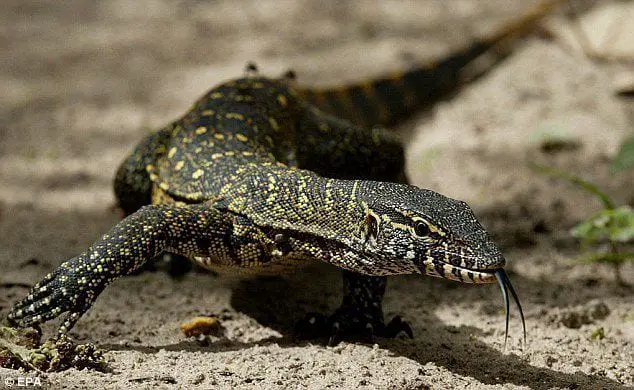
- The Nile Monitor uses its forked tongue and the organs on the roof of its mouth to taste its surroundings to help identify different chemical compounds.
- At almost 60 eggs per clutch, this Nile Monitor has the largest clutch size among the lizard family.
- The skin of the Nile monitor has been used for different purposes, such as medicine, dietary protein, cultural ceremonies, and leather making.
- The tails of a Nile Monitor may grow up to the meter. It serves as an oar to help it have power through the waters, serves as a counterweight in the running and uses its tail to whip off an assailant to defend itself.
- The martial eagle is considered as the biggest enemy of Nile Monitors because it has the ability to rupture their skin; they can carry monitors even though they have a weight of 4kg and above.
- They have a respiratory system like that of aquatic creatures allowing them to submerge in water for more than one hour.
- Provided that they have a large size and heavyweight, they have a powerful leg that makes them a fast runner.
FAQ Section
Do Nile monitors have teeth for biting and tearing their food?
Yes, they have teeth. Some types of lizards have sharp teeth, but this is not an issue to them because they swallow their prey whole.
Is a Nile monitor dangerous?
Nile monitors are a beautiful creature that is strong, large, and aggressive reptiles. They may not be a good pet that can also show their affection to you like domesticated animals such as dogs and cats do, but they are hardy animals that won’t have bodily issues from time to time. They can still be considered dangerous that is why if you are considering getting a pet Nile monitor in captivity, make sure that you have a separate, large and safe enclosure that is comparable just like their habitat.
Do lizards recognize their owners?
Despite their cold-blooded disposition, lizards can form personal relationships with people. A team of scientists has shown that lizards have the capability of recognizing their human handlers and shows signs of comfortability like tailing their tails.
What happens if a Nile Monitor bites you?
When the Nile Monitor attacks you, your skin might have some bruises, and cuts, and it may cause a fracture to your muscles, joints, or bones. Their bite is painful due to their strong jaws some also have sharp teeth.
How frequently do Nile monitors eat?
They should be fed every 2-3 days. Nile Monitors are always hungry but be sure to feed them in portions so as not to overfeed them. The amount of food given to them is about the size of their heads.
Can you eat a Nile Monitor
Nile Monitors in Central America are considered as their delicacy. It should be thoroughly cooked as it may still carry dangerous viruses and bacteria.
Do Nile monitors hibernate?
Nile Monitors hibernate during the cold season. They would hibernate in burrows or big rock cracks. They are considered as solitary, they would only have intra-species interaction during the mating season. If it is not their time of the month or if they are inactive, they are often seen in different places such as waterside, logs, trees, rocks and vegetation to bask and to rest.
Do you need a license to own a monitor lizard?
Nile Monitors are legal to own as pets in most states, but some may need some permit for you to own it.
Can a Nile monitor be tamed?
When you have taken an adult Nile Monitor in captivity, there is no possibility or it may take some time before you could successfully tame it but if you have started from hatchlings, there are high chances for you to tame it just be patient.
Do they see they see basic colors such as black and white?
Scientists are also studying the possibilities that like dinosaurs, monitor lizards also have the ability to distinguish colors. However, their ability to see in the dark is limited. Some experts suggest that they do not see the actual looks of their prey, predators or breeders but they are able to sense due to shadowy illusions that they see which is black and water matter that is moving.
How to Nile Monitors communicate?
Their primary method of communication is via their movements and posture. They also make noises such as hissing especially when they are threatened. They can also hear but they rely less on hearing compared to other senses such as the sense of taste.
What are Monitor Lizards Defense Mechanisms?
With confronted in threatening situations, they would try to puff themselves so that they would appear larger and more threatening. They would stand in an upright position with their puffing lungs and flattened back making a hissing sound and they as a final way of a protective measure, they’ll open their mouth as far as they can.

